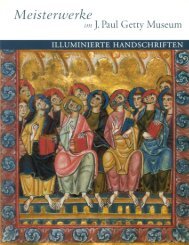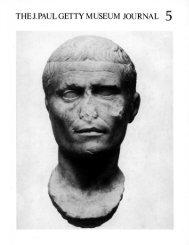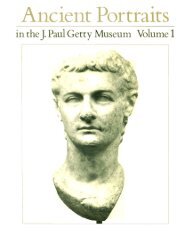The J. Paul Getty Museum Journal Volume 15 1987
The J. Paul Getty Museum Journal Volume 15 1987
The J. Paul Getty Museum Journal Volume 15 1987
You also want an ePaper? Increase the reach of your titles
YUMPU automatically turns print PDFs into web optimized ePapers that Google loves.
42 Cassidy-GeigerFigures 3a-b. Left, Ignaz Preissler (Bohemian, 1676—1741). Top of a dish decorated with allegories of fall (top) and winter(bottom), circa 17<strong>15</strong>—1720. Chinese porcelain with underglaze-blue decoration and overglaze decoration in Schwarzlotand gold. Diam: 22 cm (S n 7\6 f ). Right, bottom. Sevres, Musee National de Ceramique MNC 9703. Photos:Courtesy Musee National de Ceramique, Sevres.second series are not known.<strong>The</strong> prints representing fall and winter are thesources for the scenes on a dish in the Musee Nationalde Ceramique at Sevres (MNC 9703). <strong>The</strong> dish (figs.3a—b) was illustrated by Müller-Hofstede who attributedit to Preissler working in Breslau "before1720." 17 It is of the same Chinese porcelain as the <strong>Getty</strong>bowl with incised and underglaze-blue decoration and isdecorated on both sides in Schwarzlotwith touches ofgold. <strong>The</strong> rim is edged in silver-gilt. <strong>The</strong> triumph ofBacchus and Ariadne is painted on the top (fig. 3a), aconventional allegory for fall. <strong>The</strong> scene on the underside(fig. 3b) was interpreted by Müller-Hofstede as theOvidian flood with the survivors, Deucalion and Pyrrha,in the foreground. In the context of the print seriesand Mignard s cycle, however, the scene is intended asan allegory for winter and depicts Mignard's unusualand highly original rendering of the subject. Cybele, the"earth mother," wearing her turreted crown and recliningon the lions usually shown pulling her chariot, imploresthe sun to return while Boreas, the cold northwind and personification of winter, releases his snow-17. Müller-Hofstede (supra, note 8), pp. 23-26, figs. 34-37.18. This information courtesy of Elisabeth Fontan, formerly conservateur,Musee National de Ceramique, who with Mme AntoinetteHalle graciously permitted me access to this and other pieces in thefilledbreath over the earth. Vulcan tries to warm therecumbent Cybele with a pot of coals from his forge.<strong>The</strong> inclusion of a river god relates to the story ofClaudia, the vestal virgin who pulled a ship loaded witha sacred image of Cybele from the mud at the mouth ofthe Tiber. Since the images on the two pieces belong tothe same series, there is no question that the <strong>Getty</strong> bowland the dish at Sevres were commissioned together andform a set.<strong>The</strong> dish was acquired by the Musee National de Ceramiquefrom the 1894 sale of the collection of OctaveDu Sartel. 18Du Sartel had assigned the origins of thistype of decoration to Venice in his book La porcelaine deChine . . ., published in 1881, and called it "extremelyrare." 19<strong>The</strong> dish appeared in lot <strong>15</strong>0 in the catalogue ofthe sale as the pair to another dish of the same so-calledJapanese porcelain, which was also painted on bothsides in Schwarzlottouched with gold and edged in silver-gilt.<strong>The</strong> subject of the scene on the top of the otherdish in the lot (fig. 4a) was identified in the catalogue asDiana and Endymion, but the dish is almost certainlythat formerly in the von Dallwitz collection, which demuseum.19. Ofctave] Du Sartel, La porcelaine de Chine . . . (Paris, 1881),p. 219.








